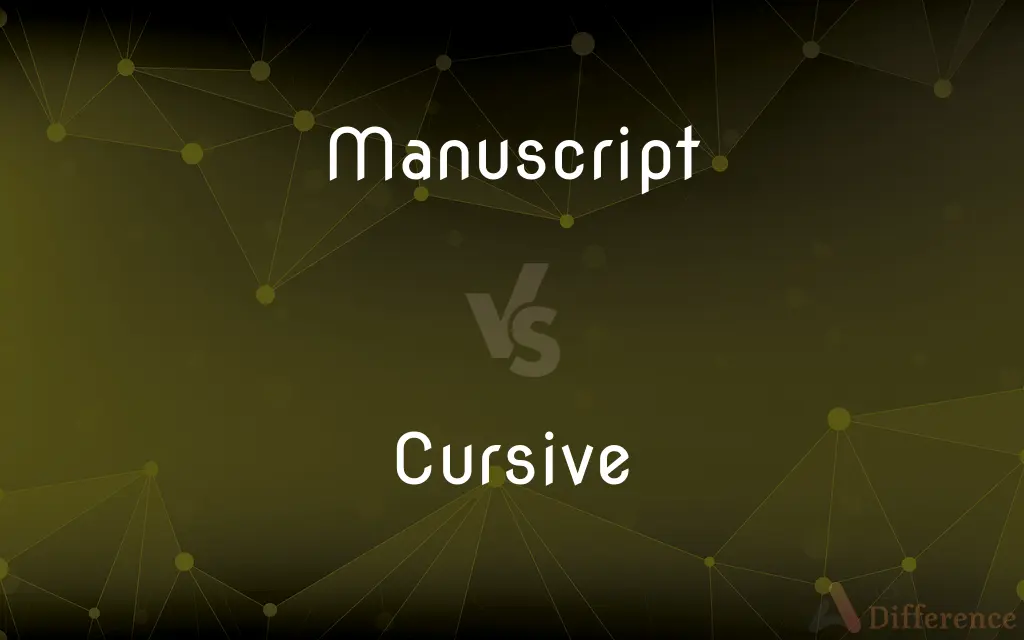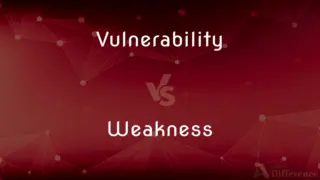Manuscript vs. Cursive — What's the Difference?
Edited by Tayyaba Rehman — By Maham Liaqat — Updated on April 1, 2024
Manuscript refers to printed letter forms, while cursive is a style of penmanship where characters are joined.

Difference Between Manuscript and Cursive
Table of Contents
ADVERTISEMENT
Key Differences
Manuscript writing, also known as print writing, involves letters that stand alone without connecting to one another. This style is often taught to beginners for its simplicity and ease of learning. On the other hand, cursive writing features letters that are connected in a flowing manner, which can increase writing speed and sometimes legibility.
In manuscript writing, each letter is distinct, making it easier for readers to distinguish between characters, which is particularly beneficial for young learners and individuals learning a new language. Whereas, cursive writing, with its connected letters, is praised for its aesthetic appeal and is sometimes considered a more advanced form of handwriting.
The primary goal of teaching manuscript writing in educational settings is to ensure clarity and ease of reading. This is especially important in early education, where the focus is on letter recognition and basic literacy skills. In contrast, cursive writing is often introduced later, with the intention of improving writing speed and developing a unique personal style.
Manuscript handwriting is generally considered more modern and is the preferred method for most printed materials, including books, signs, and digital text. Cursive, while less common in printed materials, is still valued for personal correspondence, signatures, and artistic purposes.
Despite the differences, both manuscript and cursive writing are important for developing fine motor skills and literacy. The choice between manuscript and cursive can depend on the context, personal preference, and the specific requirements of a writing task.
ADVERTISEMENT
Comparison Chart
Characters
Printed, stand-alone
Joined, flowing
Learning Stage
Early, for beginners
Later, after mastering manuscript
Legibility
High for beginners and non-native speakers
Can be high with practice
Speed
Generally slower
Faster due to connected letters
Usage
Education, most printed materials
Personal correspondence, signatures
Compare with Definitions
Manuscript
Easier for beginners.
Children learn to read and write in manuscript before moving on to cursive.
Cursive
Enhances writing speed.
Cursive is often faster than manuscript due to its flowing nature.
Manuscript
Printed letter forms.
Manuscript handwriting is taught first in many schools.
Cursive
Aesthetic appeal.
Many people find cursive handwriting to be more aesthetically pleasing.
Manuscript
Distinct characters.
In manuscript writing, each letter is clearly separated.
Cursive
Personal style.
Cursive allows for more personal expression in handwriting.
Manuscript
Preferred for early education.
Manuscript is used in early education to aid in letter recognition.
Cursive
Used for signatures.
Signatures are typically written in cursive for uniqueness and fluidity.
Manuscript
Modern and widely used.
Manuscript is the standard for most printed and digital text.
Cursive
Connected letters.
Cursive writing connects letters with loops and joins.
Manuscript
A manuscript (abbreviated MS for singular and MSS for plural) was, traditionally, any document written by hand – or, once practical typewriters became available, typewritten – as opposed to mechanically printed or reproduced in some indirect or automated way. More recently, the term has come to be understood to further include any written, typed, or word-processed copy of an author's work, as distinguished from its rendition as a printed version of the same.
Cursive
Cursive (also known as script, among other names) is any style of penmanship in which some characters are written joined together in a flowing manner, generally for the purpose of making writing faster, in contrast to block letters. Cursive handwriting is very functional, and is intended to be used in everyday writing.
Manuscript
A book, document, or piece of music written by hand rather than typed or printed
Early Gothic manuscripts
An illuminated manuscript
Cursive
Having the successive letters joined together
Cursive writing.
A cursive style of type.
Manuscript
A handwritten book, poem, or other document, or a collection of such handwritten documents bound together
The contents of the manuscript include a romance and a saint's life.
Cursive
A cursive character or letter.
Manuscript
A version of a book, article, or other work before being published or prepared for publication
The author submitted the manuscript as a text file.
Cursive
A manuscript written in cursive characters.
Manuscript
Handwriting, especially in contrast to print
Her last poems were left in manuscript.
Cursive
(Printing) A type style that imitates handwriting.
Manuscript
Handwritten, or by extension manually typewritten, as opposed to being mechanically reproduced.
Cursive
Running; flowing.
Manuscript
A book, composition or any other document, written by hand (or manually typewritten), not mechanically reproduced.
Cursive
(of writing) Having successive letters joined together.
Manuscript
A single, original copy of a book, article, composition etc, written by hand or even printed, submitted as original for (copy-editing and) reproductive publication.
Cursive
(grammar) Of or relating to a grammatical aspect relating to an action that occurs in a straight line (in space or time).
Manuscript
Written with or by the hand; not printed; as, a manuscript volume.
Cursive
(countable) A cursive character, letter or font.
Manuscript
An original literary or musical composition written by the author, formerly with the hand, now usually by typewriter or word processor. It is contrasted with a printed copy.
Cursive
(countable) A manuscript written in cursive characters.
Manuscript
Writing, as opposed to print; as, the book exists only in manuscript.
Cursive
(uncountable) Joined-up handwriting.
Manuscript
The form of a literary work submitted for publication
Cursive
Running; flowing.
Manuscript
Handwritten book or document
Cursive
A character used in cursive writing.
Cursive
A manuscript, especially of the New Testament, written in small, connected characters or in a running hand; - opposed to uncial.
Cursive
Rapid handwriting in which letters are set down in full and cursively connected within words without lifting the writing implement from the paper
Cursive
Having successive letter joined together;
Cursive script
Common Curiosities
Why is cursive writing taught?
Cursive writing is taught to improve writing speed, fluency, and personal handwriting style.
Can adults learn cursive if they only know manuscript?
Yes, adults can learn cursive with practice, improving their handwriting versatility.
Are there any benefits to learning both manuscript and cursive?
Learning both can improve fine motor skills, literacy, and adaptability in writing.
What is manuscript writing?
Manuscript writing is a form of handwriting where the letters are printed and do not connect.
Do all schools teach cursive writing?
The inclusion of cursive in school curriculums varies by region and educational philosophy.
Is manuscript or cursive better for dyslexia?
Manuscript is often recommended for individuals with dyslexia due to its clear separation of letters.
Which is faster, manuscript or cursive writing?
Cursive is generally faster than manuscript because of the connected letters.
Is there a difference in the brain's processing of manuscript vs. cursive?
Research suggests cursive writing may engage the brain differently, potentially enhancing cognitive development.
Why do signatures often use cursive?
Cursive is used for signatures due to its fluid motion and the unique personal touch it adds.
Is cursive writing becoming obsolete?
While less common in formal education, cursive is still valued for its personal and artistic applications.
Can manuscript writing be artistic?
Yes, manuscript can be artistic, especially when used in calligraphy and decorative purposes.
How do digital devices affect the use of manuscript and cursive?
Digital devices favor manuscript for readability, while cursive remains popular for personal writing.
Can learning cursive help with handwriting legibility?
Yes, learning cursive can improve handwriting legibility and fluidity for some individuals.
Which writing style is more commonly used worldwide, manuscript or cursive?
Manuscript is more commonly used worldwide, especially in educational materials and printed texts.
What are some tips for transitioning from manuscript to cursive?
Practice consistently, start with individual letters, and gradually progress to connecting letters and words.
Share Your Discovery

Previous Comparison
Bear vs. Dear
Next Comparison
Vulnerability vs. WeaknessAuthor Spotlight
Written by
Maham LiaqatEdited by
Tayyaba RehmanTayyaba Rehman is a distinguished writer, currently serving as a primary contributor to askdifference.com. As a researcher in semantics and etymology, Tayyaba's passion for the complexity of languages and their distinctions has found a perfect home on the platform. Tayyaba delves into the intricacies of language, distinguishing between commonly confused words and phrases, thereby providing clarity for readers worldwide.













































